Human Resource Management Essay: Equity, Diversity, and Inclusion
VerifiedAdded on 2022/10/08
|12
|2741
|14
Essay
AI Summary
This essay delves into the critical concepts of equity, diversity, and inclusion within human resource management, focusing on their significant impact on modern organizations. It examines the challenges of workplace diversity, particularly concerning cultural differences and legal compliance. The essay references articles that highlight the issues and challenges of workplace diversity. It explores the importance of fostering an inclusive environment where individual differences are valued and employees are treated fairly, emphasizing the benefits of diversity in terms of increased productivity, creativity, and employee satisfaction. The essay covers various HRM practices, including recruitment, training and development, and pay and rewards, discussing issues such as discrimination, equal opportunity, and the need for fair and unbiased procedures. It also highlights the benefits of workplace diversity, such as employee development, growth, and the ability to attract and retain customers and employees. The essay emphasizes the need for a management philosophy that recognizes diversity as critical for organizational success.
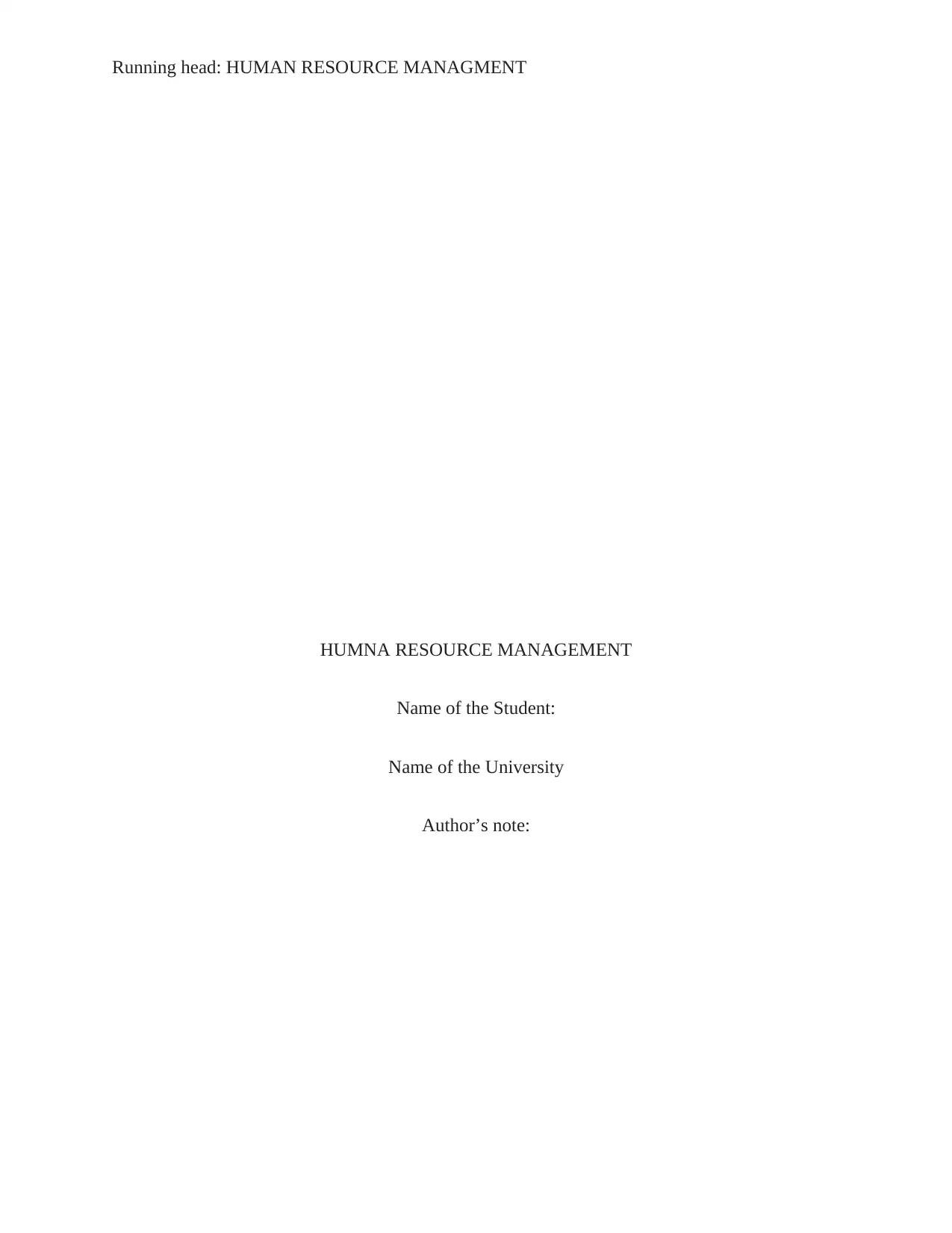
Running head: HUMAN RESOURCE MANAGMENT
HUMNA RESOURCE MANAGEMENT
Name of the Student:
Name of the University
Author’s note:
HUMNA RESOURCE MANAGEMENT
Name of the Student:
Name of the University
Author’s note:
Paraphrase This Document
Need a fresh take? Get an instant paraphrase of this document with our AI Paraphraser
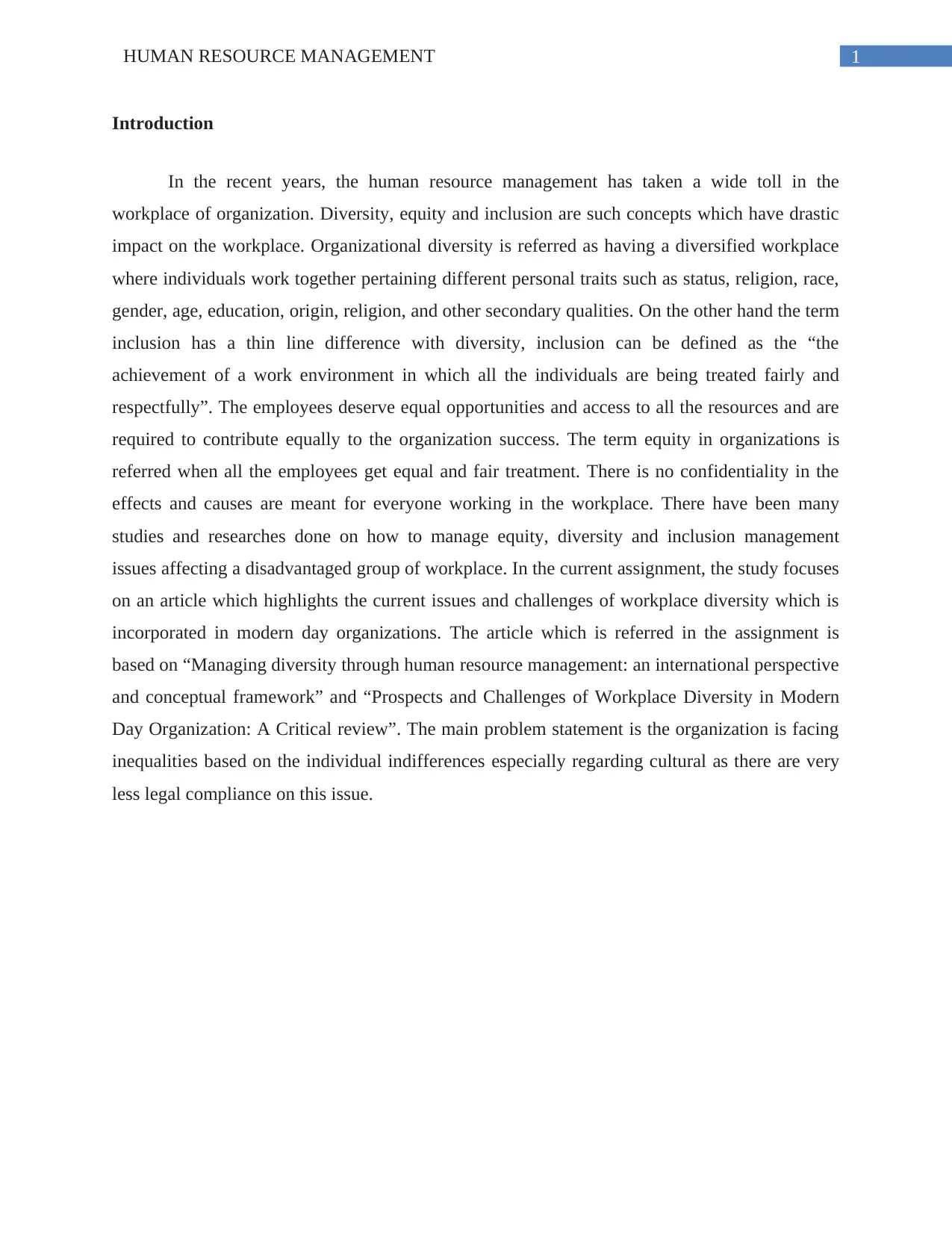
1HUMAN RESOURCE MANAGEMENT
Introduction
In the recent years, the human resource management has taken a wide toll in the
workplace of organization. Diversity, equity and inclusion are such concepts which have drastic
impact on the workplace. Organizational diversity is referred as having a diversified workplace
where individuals work together pertaining different personal traits such as status, religion, race,
gender, age, education, origin, religion, and other secondary qualities. On the other hand the term
inclusion has a thin line difference with diversity, inclusion can be defined as the “the
achievement of a work environment in which all the individuals are being treated fairly and
respectfully”. The employees deserve equal opportunities and access to all the resources and are
required to contribute equally to the organization success. The term equity in organizations is
referred when all the employees get equal and fair treatment. There is no confidentiality in the
effects and causes are meant for everyone working in the workplace. There have been many
studies and researches done on how to manage equity, diversity and inclusion management
issues affecting a disadvantaged group of workplace. In the current assignment, the study focuses
on an article which highlights the current issues and challenges of workplace diversity which is
incorporated in modern day organizations. The article which is referred in the assignment is
based on “Managing diversity through human resource management: an international perspective
and conceptual framework” and “Prospects and Challenges of Workplace Diversity in Modern
Day Organization: A Critical review”. The main problem statement is the organization is facing
inequalities based on the individual indifferences especially regarding cultural as there are very
less legal compliance on this issue.
Introduction
In the recent years, the human resource management has taken a wide toll in the
workplace of organization. Diversity, equity and inclusion are such concepts which have drastic
impact on the workplace. Organizational diversity is referred as having a diversified workplace
where individuals work together pertaining different personal traits such as status, religion, race,
gender, age, education, origin, religion, and other secondary qualities. On the other hand the term
inclusion has a thin line difference with diversity, inclusion can be defined as the “the
achievement of a work environment in which all the individuals are being treated fairly and
respectfully”. The employees deserve equal opportunities and access to all the resources and are
required to contribute equally to the organization success. The term equity in organizations is
referred when all the employees get equal and fair treatment. There is no confidentiality in the
effects and causes are meant for everyone working in the workplace. There have been many
studies and researches done on how to manage equity, diversity and inclusion management
issues affecting a disadvantaged group of workplace. In the current assignment, the study focuses
on an article which highlights the current issues and challenges of workplace diversity which is
incorporated in modern day organizations. The article which is referred in the assignment is
based on “Managing diversity through human resource management: an international perspective
and conceptual framework” and “Prospects and Challenges of Workplace Diversity in Modern
Day Organization: A Critical review”. The main problem statement is the organization is facing
inequalities based on the individual indifferences especially regarding cultural as there are very
less legal compliance on this issue.
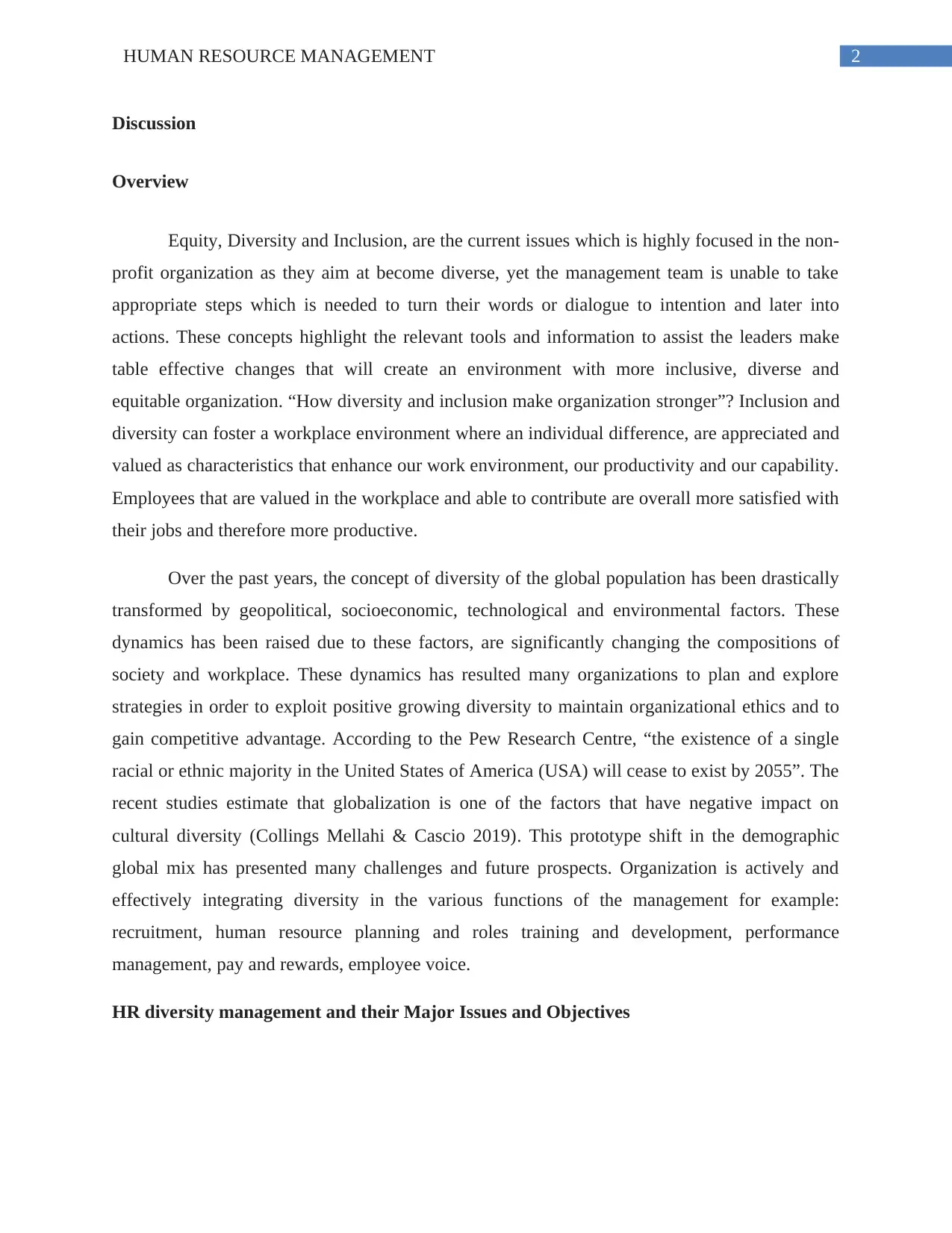
2HUMAN RESOURCE MANAGEMENT
Discussion
Overview
Equity, Diversity and Inclusion, are the current issues which is highly focused in the non-
profit organization as they aim at become diverse, yet the management team is unable to take
appropriate steps which is needed to turn their words or dialogue to intention and later into
actions. These concepts highlight the relevant tools and information to assist the leaders make
table effective changes that will create an environment with more inclusive, diverse and
equitable organization. “How diversity and inclusion make organization stronger”? Inclusion and
diversity can foster a workplace environment where an individual difference, are appreciated and
valued as characteristics that enhance our work environment, our productivity and our capability.
Employees that are valued in the workplace and able to contribute are overall more satisfied with
their jobs and therefore more productive.
Over the past years, the concept of diversity of the global population has been drastically
transformed by geopolitical, socioeconomic, technological and environmental factors. These
dynamics has been raised due to these factors, are significantly changing the compositions of
society and workplace. These dynamics has resulted many organizations to plan and explore
strategies in order to exploit positive growing diversity to maintain organizational ethics and to
gain competitive advantage. According to the Pew Research Centre, “the existence of a single
racial or ethnic majority in the United States of America (USA) will cease to exist by 2055”. The
recent studies estimate that globalization is one of the factors that have negative impact on
cultural diversity (Collings Mellahi & Cascio 2019). This prototype shift in the demographic
global mix has presented many challenges and future prospects. Organization is actively and
effectively integrating diversity in the various functions of the management for example:
recruitment, human resource planning and roles training and development, performance
management, pay and rewards, employee voice.
HR diversity management and their Major Issues and Objectives
Discussion
Overview
Equity, Diversity and Inclusion, are the current issues which is highly focused in the non-
profit organization as they aim at become diverse, yet the management team is unable to take
appropriate steps which is needed to turn their words or dialogue to intention and later into
actions. These concepts highlight the relevant tools and information to assist the leaders make
table effective changes that will create an environment with more inclusive, diverse and
equitable organization. “How diversity and inclusion make organization stronger”? Inclusion and
diversity can foster a workplace environment where an individual difference, are appreciated and
valued as characteristics that enhance our work environment, our productivity and our capability.
Employees that are valued in the workplace and able to contribute are overall more satisfied with
their jobs and therefore more productive.
Over the past years, the concept of diversity of the global population has been drastically
transformed by geopolitical, socioeconomic, technological and environmental factors. These
dynamics has been raised due to these factors, are significantly changing the compositions of
society and workplace. These dynamics has resulted many organizations to plan and explore
strategies in order to exploit positive growing diversity to maintain organizational ethics and to
gain competitive advantage. According to the Pew Research Centre, “the existence of a single
racial or ethnic majority in the United States of America (USA) will cease to exist by 2055”. The
recent studies estimate that globalization is one of the factors that have negative impact on
cultural diversity (Collings Mellahi & Cascio 2019). This prototype shift in the demographic
global mix has presented many challenges and future prospects. Organization is actively and
effectively integrating diversity in the various functions of the management for example:
recruitment, human resource planning and roles training and development, performance
management, pay and rewards, employee voice.
HR diversity management and their Major Issues and Objectives
⊘ This is a preview!⊘
Do you want full access?
Subscribe today to unlock all pages.

Trusted by 1+ million students worldwide
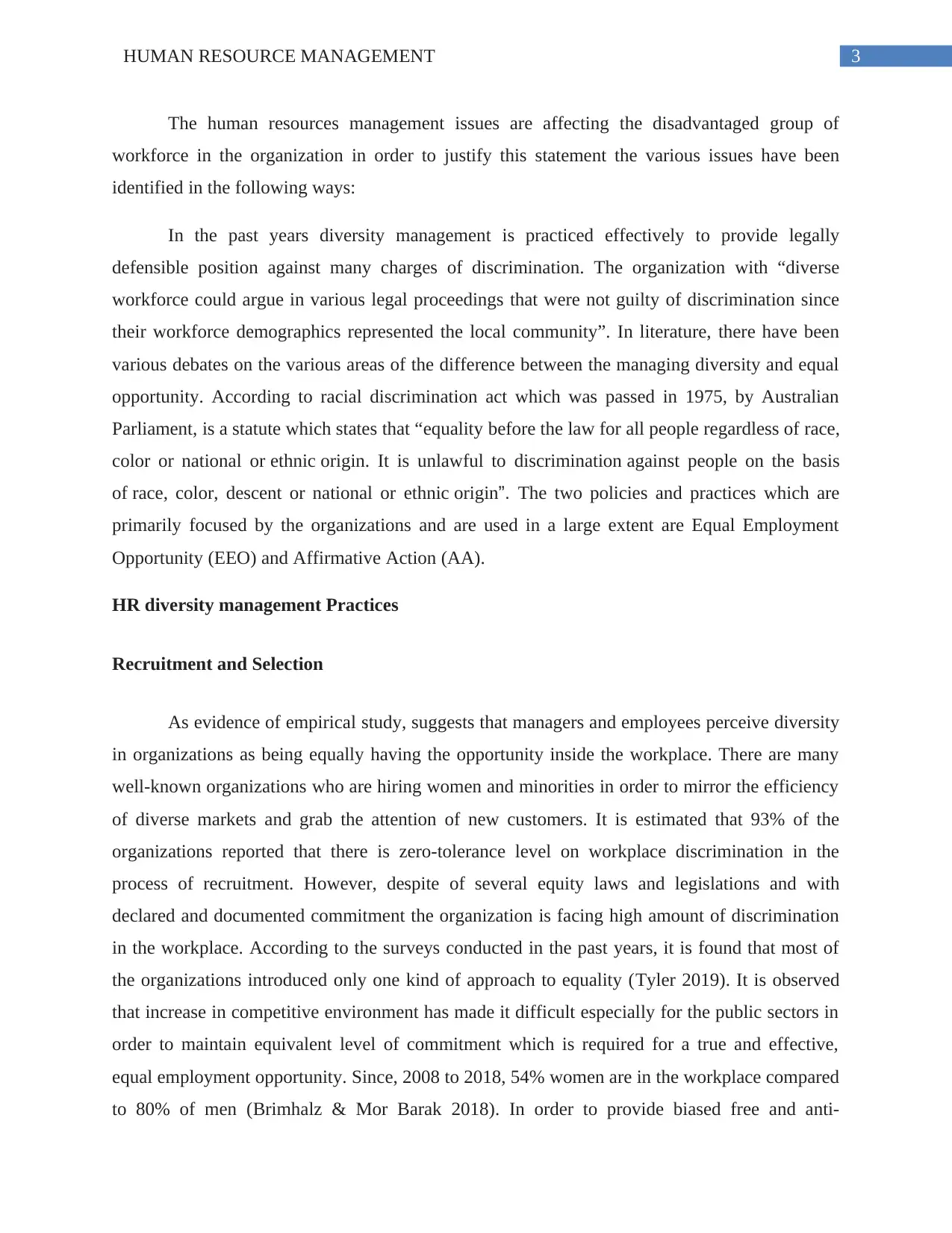
3HUMAN RESOURCE MANAGEMENT
The human resources management issues are affecting the disadvantaged group of
workforce in the organization in order to justify this statement the various issues have been
identified in the following ways:
In the past years diversity management is practiced effectively to provide legally
defensible position against many charges of discrimination. The organization with “diverse
workforce could argue in various legal proceedings that were not guilty of discrimination since
their workforce demographics represented the local community”. In literature, there have been
various debates on the various areas of the difference between the managing diversity and equal
opportunity. According to racial discrimination act which was passed in 1975, by Australian
Parliament, is a statute which states that “equality before the law for all people regardless of race,
color or national or ethnic origin. It is unlawful to discrimination against people on the basis
of race, color, descent or national or ethnic origin”. The two policies and practices which are
primarily focused by the organizations and are used in a large extent are Equal Employment
Opportunity (EEO) and Affirmative Action (AA).
HR diversity management Practices
Recruitment and Selection
As evidence of empirical study, suggests that managers and employees perceive diversity
in organizations as being equally having the opportunity inside the workplace. There are many
well-known organizations who are hiring women and minorities in order to mirror the efficiency
of diverse markets and grab the attention of new customers. It is estimated that 93% of the
organizations reported that there is zero-tolerance level on workplace discrimination in the
process of recruitment. However, despite of several equity laws and legislations and with
declared and documented commitment the organization is facing high amount of discrimination
in the workplace. According to the surveys conducted in the past years, it is found that most of
the organizations introduced only one kind of approach to equality (Tyler 2019). It is observed
that increase in competitive environment has made it difficult especially for the public sectors in
order to maintain equivalent level of commitment which is required for a true and effective,
equal employment opportunity. Since, 2008 to 2018, 54% women are in the workplace compared
to 80% of men (Brimhalz & Mor Barak 2018). In order to provide biased free and anti-
The human resources management issues are affecting the disadvantaged group of
workforce in the organization in order to justify this statement the various issues have been
identified in the following ways:
In the past years diversity management is practiced effectively to provide legally
defensible position against many charges of discrimination. The organization with “diverse
workforce could argue in various legal proceedings that were not guilty of discrimination since
their workforce demographics represented the local community”. In literature, there have been
various debates on the various areas of the difference between the managing diversity and equal
opportunity. According to racial discrimination act which was passed in 1975, by Australian
Parliament, is a statute which states that “equality before the law for all people regardless of race,
color or national or ethnic origin. It is unlawful to discrimination against people on the basis
of race, color, descent or national or ethnic origin”. The two policies and practices which are
primarily focused by the organizations and are used in a large extent are Equal Employment
Opportunity (EEO) and Affirmative Action (AA).
HR diversity management Practices
Recruitment and Selection
As evidence of empirical study, suggests that managers and employees perceive diversity
in organizations as being equally having the opportunity inside the workplace. There are many
well-known organizations who are hiring women and minorities in order to mirror the efficiency
of diverse markets and grab the attention of new customers. It is estimated that 93% of the
organizations reported that there is zero-tolerance level on workplace discrimination in the
process of recruitment. However, despite of several equity laws and legislations and with
declared and documented commitment the organization is facing high amount of discrimination
in the workplace. According to the surveys conducted in the past years, it is found that most of
the organizations introduced only one kind of approach to equality (Tyler 2019). It is observed
that increase in competitive environment has made it difficult especially for the public sectors in
order to maintain equivalent level of commitment which is required for a true and effective,
equal employment opportunity. Since, 2008 to 2018, 54% women are in the workplace compared
to 80% of men (Brimhalz & Mor Barak 2018). In order to provide biased free and anti-
Paraphrase This Document
Need a fresh take? Get an instant paraphrase of this document with our AI Paraphraser
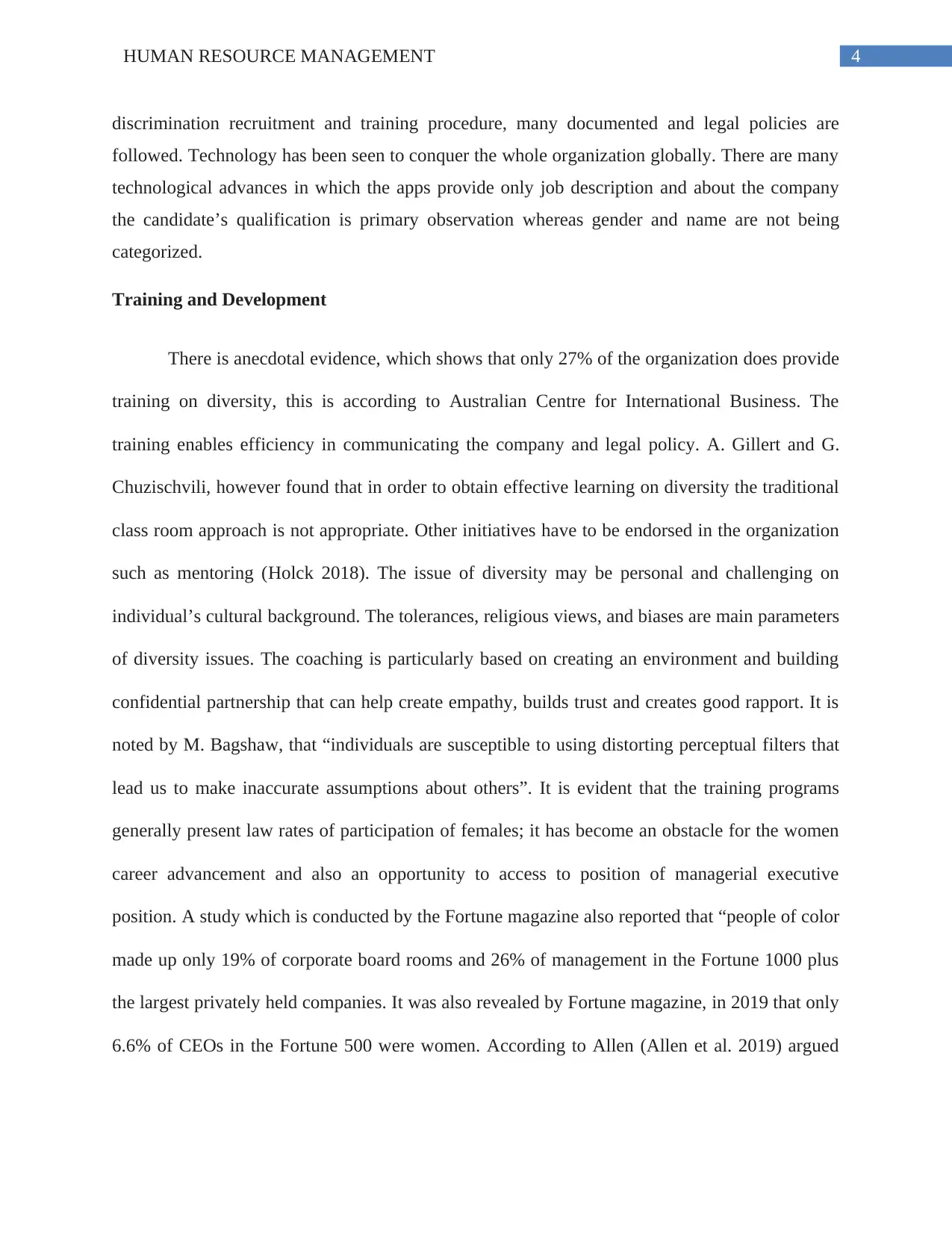
4HUMAN RESOURCE MANAGEMENT
discrimination recruitment and training procedure, many documented and legal policies are
followed. Technology has been seen to conquer the whole organization globally. There are many
technological advances in which the apps provide only job description and about the company
the candidate’s qualification is primary observation whereas gender and name are not being
categorized.
Training and Development
There is anecdotal evidence, which shows that only 27% of the organization does provide
training on diversity, this is according to Australian Centre for International Business. The
training enables efficiency in communicating the company and legal policy. A. Gillert and G.
Chuzischvili, however found that in order to obtain effective learning on diversity the traditional
class room approach is not appropriate. Other initiatives have to be endorsed in the organization
such as mentoring (Holck 2018). The issue of diversity may be personal and challenging on
individual’s cultural background. The tolerances, religious views, and biases are main parameters
of diversity issues. The coaching is particularly based on creating an environment and building
confidential partnership that can help create empathy, builds trust and creates good rapport. It is
noted by M. Bagshaw, that “individuals are susceptible to using distorting perceptual filters that
lead us to make inaccurate assumptions about others”. It is evident that the training programs
generally present law rates of participation of females; it has become an obstacle for the women
career advancement and also an opportunity to access to position of managerial executive
position. A study which is conducted by the Fortune magazine also reported that “people of color
made up only 19% of corporate board rooms and 26% of management in the Fortune 1000 plus
the largest privately held companies. It was also revealed by Fortune magazine, in 2019 that only
6.6% of CEOs in the Fortune 500 were women. According to Allen (Allen et al. 2019) argued
discrimination recruitment and training procedure, many documented and legal policies are
followed. Technology has been seen to conquer the whole organization globally. There are many
technological advances in which the apps provide only job description and about the company
the candidate’s qualification is primary observation whereas gender and name are not being
categorized.
Training and Development
There is anecdotal evidence, which shows that only 27% of the organization does provide
training on diversity, this is according to Australian Centre for International Business. The
training enables efficiency in communicating the company and legal policy. A. Gillert and G.
Chuzischvili, however found that in order to obtain effective learning on diversity the traditional
class room approach is not appropriate. Other initiatives have to be endorsed in the organization
such as mentoring (Holck 2018). The issue of diversity may be personal and challenging on
individual’s cultural background. The tolerances, religious views, and biases are main parameters
of diversity issues. The coaching is particularly based on creating an environment and building
confidential partnership that can help create empathy, builds trust and creates good rapport. It is
noted by M. Bagshaw, that “individuals are susceptible to using distorting perceptual filters that
lead us to make inaccurate assumptions about others”. It is evident that the training programs
generally present law rates of participation of females; it has become an obstacle for the women
career advancement and also an opportunity to access to position of managerial executive
position. A study which is conducted by the Fortune magazine also reported that “people of color
made up only 19% of corporate board rooms and 26% of management in the Fortune 1000 plus
the largest privately held companies. It was also revealed by Fortune magazine, in 2019 that only
6.6% of CEOs in the Fortune 500 were women. According to Allen (Allen et al. 2019) argued
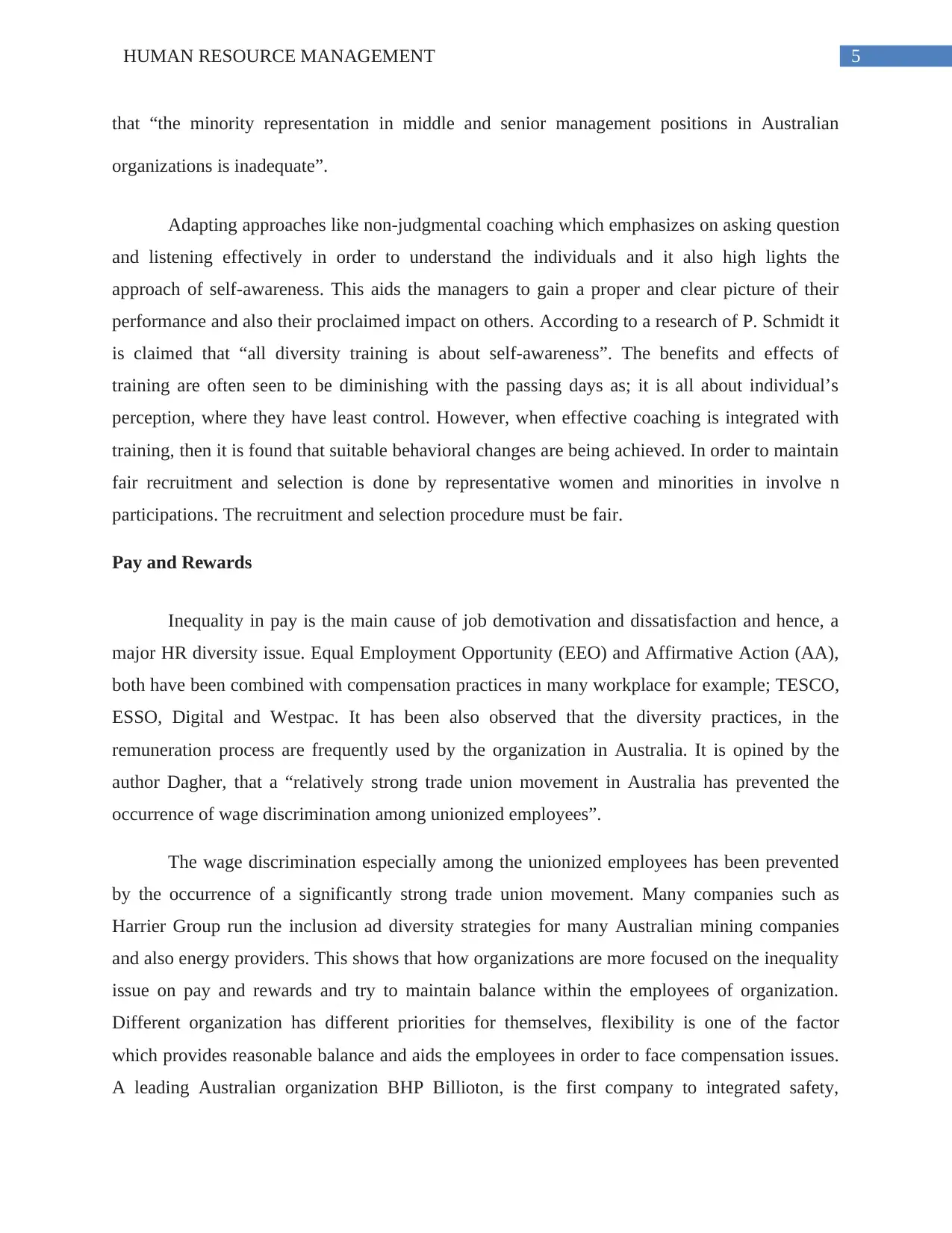
5HUMAN RESOURCE MANAGEMENT
that “the minority representation in middle and senior management positions in Australian
organizations is inadequate”.
Adapting approaches like non-judgmental coaching which emphasizes on asking question
and listening effectively in order to understand the individuals and it also high lights the
approach of self-awareness. This aids the managers to gain a proper and clear picture of their
performance and also their proclaimed impact on others. According to a research of P. Schmidt it
is claimed that “all diversity training is about self-awareness”. The benefits and effects of
training are often seen to be diminishing with the passing days as; it is all about individual’s
perception, where they have least control. However, when effective coaching is integrated with
training, then it is found that suitable behavioral changes are being achieved. In order to maintain
fair recruitment and selection is done by representative women and minorities in involve n
participations. The recruitment and selection procedure must be fair.
Pay and Rewards
Inequality in pay is the main cause of job demotivation and dissatisfaction and hence, a
major HR diversity issue. Equal Employment Opportunity (EEO) and Affirmative Action (AA),
both have been combined with compensation practices in many workplace for example; TESCO,
ESSO, Digital and Westpac. It has been also observed that the diversity practices, in the
remuneration process are frequently used by the organization in Australia. It is opined by the
author Dagher, that a “relatively strong trade union movement in Australia has prevented the
occurrence of wage discrimination among unionized employees”.
The wage discrimination especially among the unionized employees has been prevented
by the occurrence of a significantly strong trade union movement. Many companies such as
Harrier Group run the inclusion ad diversity strategies for many Australian mining companies
and also energy providers. This shows that how organizations are more focused on the inequality
issue on pay and rewards and try to maintain balance within the employees of organization.
Different organization has different priorities for themselves, flexibility is one of the factor
which provides reasonable balance and aids the employees in order to face compensation issues.
A leading Australian organization BHP Billioton, is the first company to integrated safety,
that “the minority representation in middle and senior management positions in Australian
organizations is inadequate”.
Adapting approaches like non-judgmental coaching which emphasizes on asking question
and listening effectively in order to understand the individuals and it also high lights the
approach of self-awareness. This aids the managers to gain a proper and clear picture of their
performance and also their proclaimed impact on others. According to a research of P. Schmidt it
is claimed that “all diversity training is about self-awareness”. The benefits and effects of
training are often seen to be diminishing with the passing days as; it is all about individual’s
perception, where they have least control. However, when effective coaching is integrated with
training, then it is found that suitable behavioral changes are being achieved. In order to maintain
fair recruitment and selection is done by representative women and minorities in involve n
participations. The recruitment and selection procedure must be fair.
Pay and Rewards
Inequality in pay is the main cause of job demotivation and dissatisfaction and hence, a
major HR diversity issue. Equal Employment Opportunity (EEO) and Affirmative Action (AA),
both have been combined with compensation practices in many workplace for example; TESCO,
ESSO, Digital and Westpac. It has been also observed that the diversity practices, in the
remuneration process are frequently used by the organization in Australia. It is opined by the
author Dagher, that a “relatively strong trade union movement in Australia has prevented the
occurrence of wage discrimination among unionized employees”.
The wage discrimination especially among the unionized employees has been prevented
by the occurrence of a significantly strong trade union movement. Many companies such as
Harrier Group run the inclusion ad diversity strategies for many Australian mining companies
and also energy providers. This shows that how organizations are more focused on the inequality
issue on pay and rewards and try to maintain balance within the employees of organization.
Different organization has different priorities for themselves, flexibility is one of the factor
which provides reasonable balance and aids the employees in order to face compensation issues.
A leading Australian organization BHP Billioton, is the first company to integrated safety,
⊘ This is a preview!⊘
Do you want full access?
Subscribe today to unlock all pages.

Trusted by 1+ million students worldwide
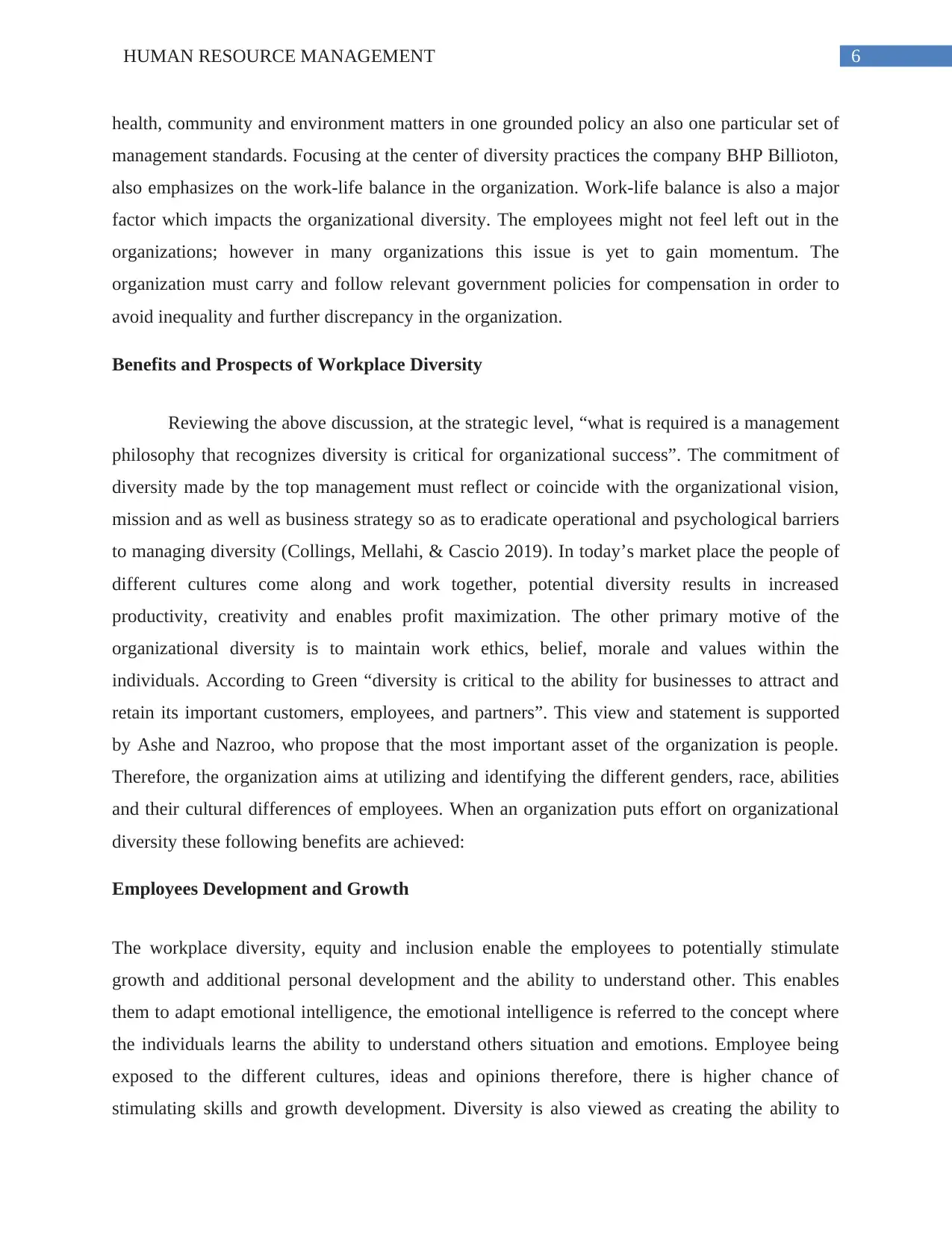
6HUMAN RESOURCE MANAGEMENT
health, community and environment matters in one grounded policy an also one particular set of
management standards. Focusing at the center of diversity practices the company BHP Billioton,
also emphasizes on the work-life balance in the organization. Work-life balance is also a major
factor which impacts the organizational diversity. The employees might not feel left out in the
organizations; however in many organizations this issue is yet to gain momentum. The
organization must carry and follow relevant government policies for compensation in order to
avoid inequality and further discrepancy in the organization.
Benefits and Prospects of Workplace Diversity
Reviewing the above discussion, at the strategic level, “what is required is a management
philosophy that recognizes diversity is critical for organizational success”. The commitment of
diversity made by the top management must reflect or coincide with the organizational vision,
mission and as well as business strategy so as to eradicate operational and psychological barriers
to managing diversity (Collings, Mellahi, & Cascio 2019). In today’s market place the people of
different cultures come along and work together, potential diversity results in increased
productivity, creativity and enables profit maximization. The other primary motive of the
organizational diversity is to maintain work ethics, belief, morale and values within the
individuals. According to Green “diversity is critical to the ability for businesses to attract and
retain its important customers, employees, and partners”. This view and statement is supported
by Ashe and Nazroo, who propose that the most important asset of the organization is people.
Therefore, the organization aims at utilizing and identifying the different genders, race, abilities
and their cultural differences of employees. When an organization puts effort on organizational
diversity these following benefits are achieved:
Employees Development and Growth
The workplace diversity, equity and inclusion enable the employees to potentially stimulate
growth and additional personal development and the ability to understand other. This enables
them to adapt emotional intelligence, the emotional intelligence is referred to the concept where
the individuals learns the ability to understand others situation and emotions. Employee being
exposed to the different cultures, ideas and opinions therefore, there is higher chance of
stimulating skills and growth development. Diversity is also viewed as creating the ability to
health, community and environment matters in one grounded policy an also one particular set of
management standards. Focusing at the center of diversity practices the company BHP Billioton,
also emphasizes on the work-life balance in the organization. Work-life balance is also a major
factor which impacts the organizational diversity. The employees might not feel left out in the
organizations; however in many organizations this issue is yet to gain momentum. The
organization must carry and follow relevant government policies for compensation in order to
avoid inequality and further discrepancy in the organization.
Benefits and Prospects of Workplace Diversity
Reviewing the above discussion, at the strategic level, “what is required is a management
philosophy that recognizes diversity is critical for organizational success”. The commitment of
diversity made by the top management must reflect or coincide with the organizational vision,
mission and as well as business strategy so as to eradicate operational and psychological barriers
to managing diversity (Collings, Mellahi, & Cascio 2019). In today’s market place the people of
different cultures come along and work together, potential diversity results in increased
productivity, creativity and enables profit maximization. The other primary motive of the
organizational diversity is to maintain work ethics, belief, morale and values within the
individuals. According to Green “diversity is critical to the ability for businesses to attract and
retain its important customers, employees, and partners”. This view and statement is supported
by Ashe and Nazroo, who propose that the most important asset of the organization is people.
Therefore, the organization aims at utilizing and identifying the different genders, race, abilities
and their cultural differences of employees. When an organization puts effort on organizational
diversity these following benefits are achieved:
Employees Development and Growth
The workplace diversity, equity and inclusion enable the employees to potentially stimulate
growth and additional personal development and the ability to understand other. This enables
them to adapt emotional intelligence, the emotional intelligence is referred to the concept where
the individuals learns the ability to understand others situation and emotions. Employee being
exposed to the different cultures, ideas and opinions therefore, there is higher chance of
stimulating skills and growth development. Diversity is also viewed as creating the ability to
Paraphrase This Document
Need a fresh take? Get an instant paraphrase of this document with our AI Paraphraser
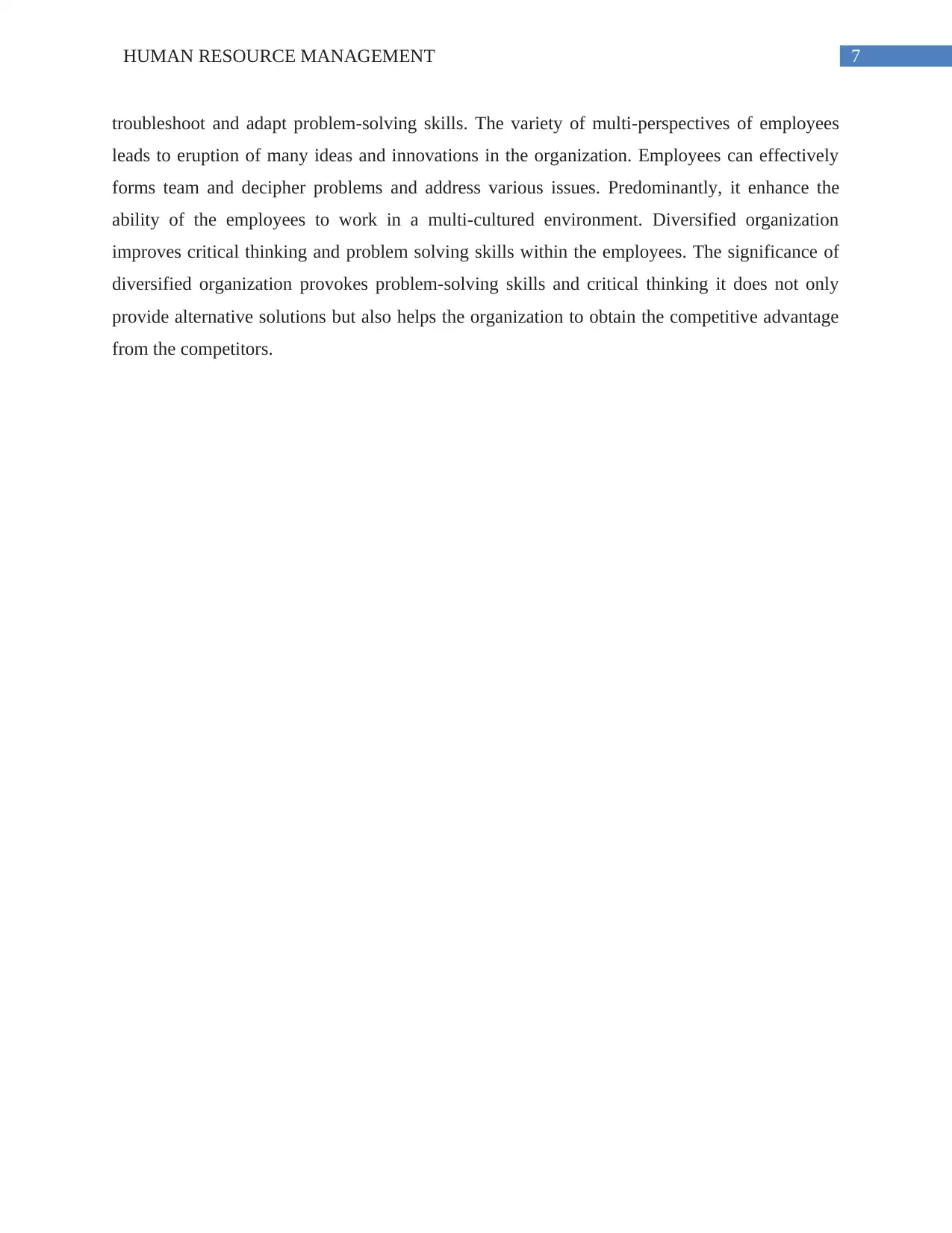
7HUMAN RESOURCE MANAGEMENT
troubleshoot and adapt problem-solving skills. The variety of multi-perspectives of employees
leads to eruption of many ideas and innovations in the organization. Employees can effectively
forms team and decipher problems and address various issues. Predominantly, it enhance the
ability of the employees to work in a multi-cultured environment. Diversified organization
improves critical thinking and problem solving skills within the employees. The significance of
diversified organization provokes problem-solving skills and critical thinking it does not only
provide alternative solutions but also helps the organization to obtain the competitive advantage
from the competitors.
troubleshoot and adapt problem-solving skills. The variety of multi-perspectives of employees
leads to eruption of many ideas and innovations in the organization. Employees can effectively
forms team and decipher problems and address various issues. Predominantly, it enhance the
ability of the employees to work in a multi-cultured environment. Diversified organization
improves critical thinking and problem solving skills within the employees. The significance of
diversified organization provokes problem-solving skills and critical thinking it does not only
provide alternative solutions but also helps the organization to obtain the competitive advantage
from the competitors.
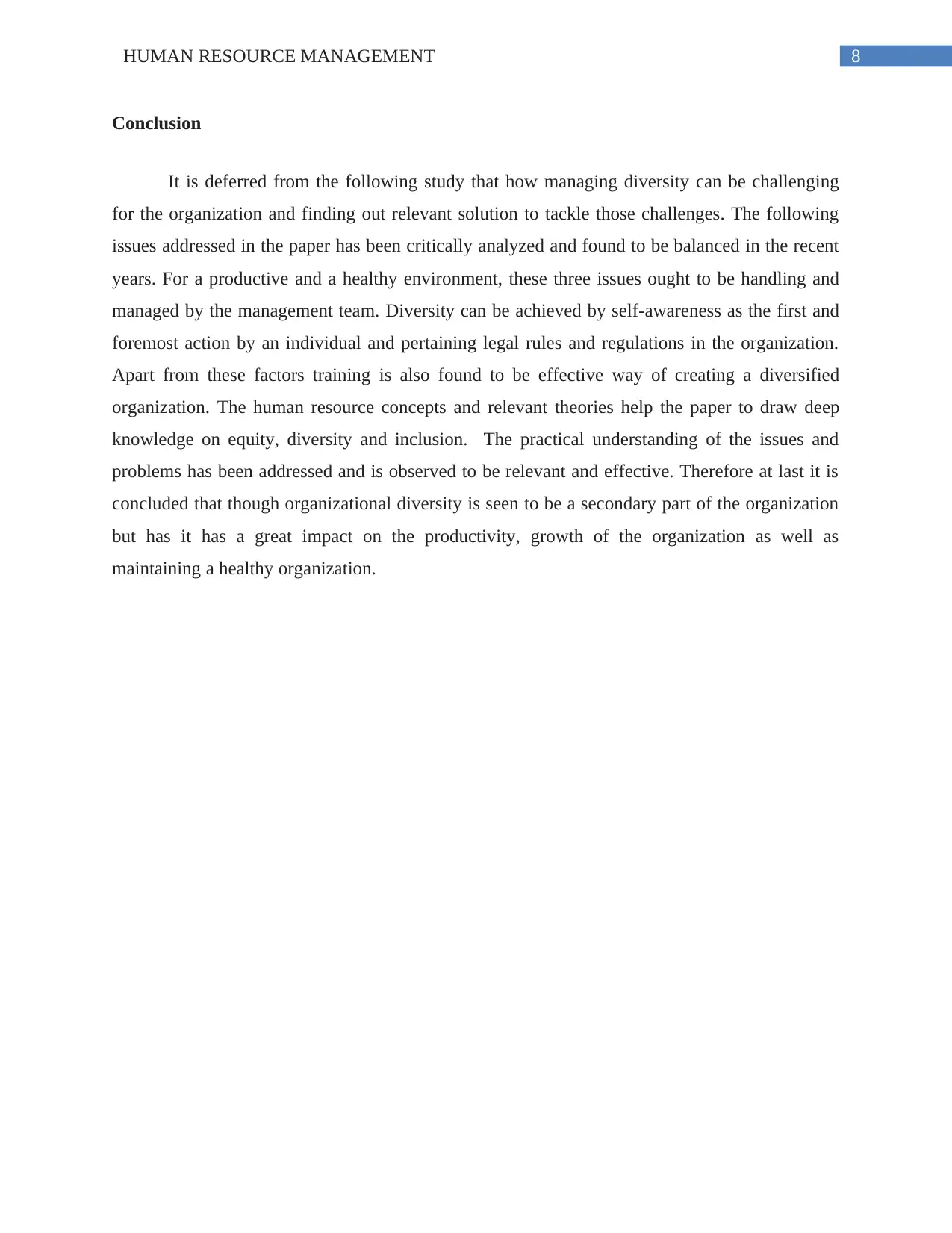
8HUMAN RESOURCE MANAGEMENT
Conclusion
It is deferred from the following study that how managing diversity can be challenging
for the organization and finding out relevant solution to tackle those challenges. The following
issues addressed in the paper has been critically analyzed and found to be balanced in the recent
years. For a productive and a healthy environment, these three issues ought to be handling and
managed by the management team. Diversity can be achieved by self-awareness as the first and
foremost action by an individual and pertaining legal rules and regulations in the organization.
Apart from these factors training is also found to be effective way of creating a diversified
organization. The human resource concepts and relevant theories help the paper to draw deep
knowledge on equity, diversity and inclusion. The practical understanding of the issues and
problems has been addressed and is observed to be relevant and effective. Therefore at last it is
concluded that though organizational diversity is seen to be a secondary part of the organization
but has it has a great impact on the productivity, growth of the organization as well as
maintaining a healthy organization.
Conclusion
It is deferred from the following study that how managing diversity can be challenging
for the organization and finding out relevant solution to tackle those challenges. The following
issues addressed in the paper has been critically analyzed and found to be balanced in the recent
years. For a productive and a healthy environment, these three issues ought to be handling and
managed by the management team. Diversity can be achieved by self-awareness as the first and
foremost action by an individual and pertaining legal rules and regulations in the organization.
Apart from these factors training is also found to be effective way of creating a diversified
organization. The human resource concepts and relevant theories help the paper to draw deep
knowledge on equity, diversity and inclusion. The practical understanding of the issues and
problems has been addressed and is observed to be relevant and effective. Therefore at last it is
concluded that though organizational diversity is seen to be a secondary part of the organization
but has it has a great impact on the productivity, growth of the organization as well as
maintaining a healthy organization.
⊘ This is a preview!⊘
Do you want full access?
Subscribe today to unlock all pages.

Trusted by 1+ million students worldwide
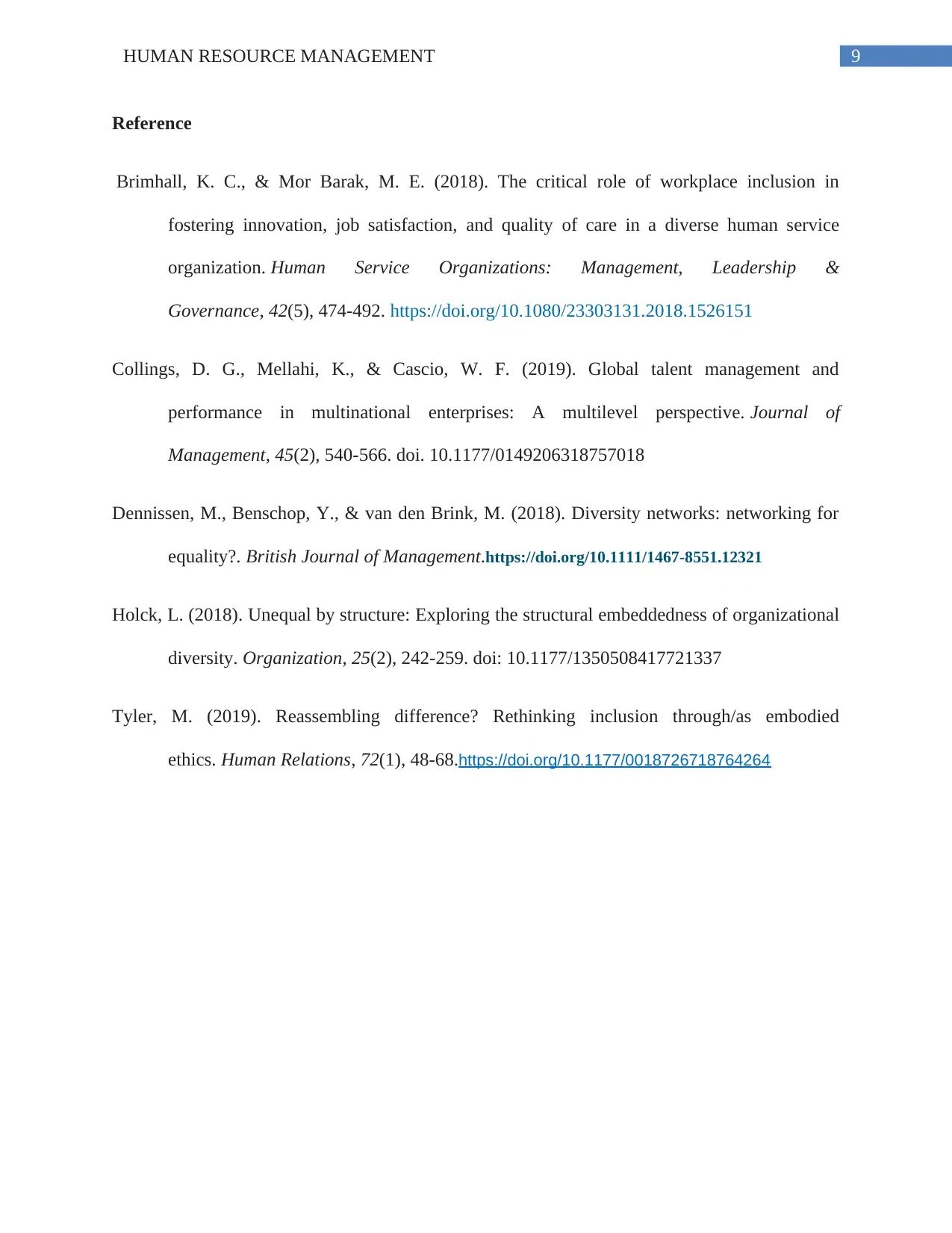
9HUMAN RESOURCE MANAGEMENT
Reference
Brimhall, K. C., & Mor Barak, M. E. (2018). The critical role of workplace inclusion in
fostering innovation, job satisfaction, and quality of care in a diverse human service
organization. Human Service Organizations: Management, Leadership &
Governance, 42(5), 474-492. https://doi.org/10.1080/23303131.2018.1526151
Collings, D. G., Mellahi, K., & Cascio, W. F. (2019). Global talent management and
performance in multinational enterprises: A multilevel perspective. Journal of
Management, 45(2), 540-566. doi. 10.1177/0149206318757018
Dennissen, M., Benschop, Y., & van den Brink, M. (2018). Diversity networks: networking for
equality?. British Journal of Management.https://doi.org/10.1111/1467-8551.12321
Holck, L. (2018). Unequal by structure: Exploring the structural embeddedness of organizational
diversity. Organization, 25(2), 242-259. doi: 10.1177/1350508417721337
Tyler, M. (2019). Reassembling difference? Rethinking inclusion through/as embodied
ethics. Human Relations, 72(1), 48-68.https://doi.org/10.1177/0018726718764264
Reference
Brimhall, K. C., & Mor Barak, M. E. (2018). The critical role of workplace inclusion in
fostering innovation, job satisfaction, and quality of care in a diverse human service
organization. Human Service Organizations: Management, Leadership &
Governance, 42(5), 474-492. https://doi.org/10.1080/23303131.2018.1526151
Collings, D. G., Mellahi, K., & Cascio, W. F. (2019). Global talent management and
performance in multinational enterprises: A multilevel perspective. Journal of
Management, 45(2), 540-566. doi. 10.1177/0149206318757018
Dennissen, M., Benschop, Y., & van den Brink, M. (2018). Diversity networks: networking for
equality?. British Journal of Management.https://doi.org/10.1111/1467-8551.12321
Holck, L. (2018). Unequal by structure: Exploring the structural embeddedness of organizational
diversity. Organization, 25(2), 242-259. doi: 10.1177/1350508417721337
Tyler, M. (2019). Reassembling difference? Rethinking inclusion through/as embodied
ethics. Human Relations, 72(1), 48-68.https://doi.org/10.1177/0018726718764264
Paraphrase This Document
Need a fresh take? Get an instant paraphrase of this document with our AI Paraphraser
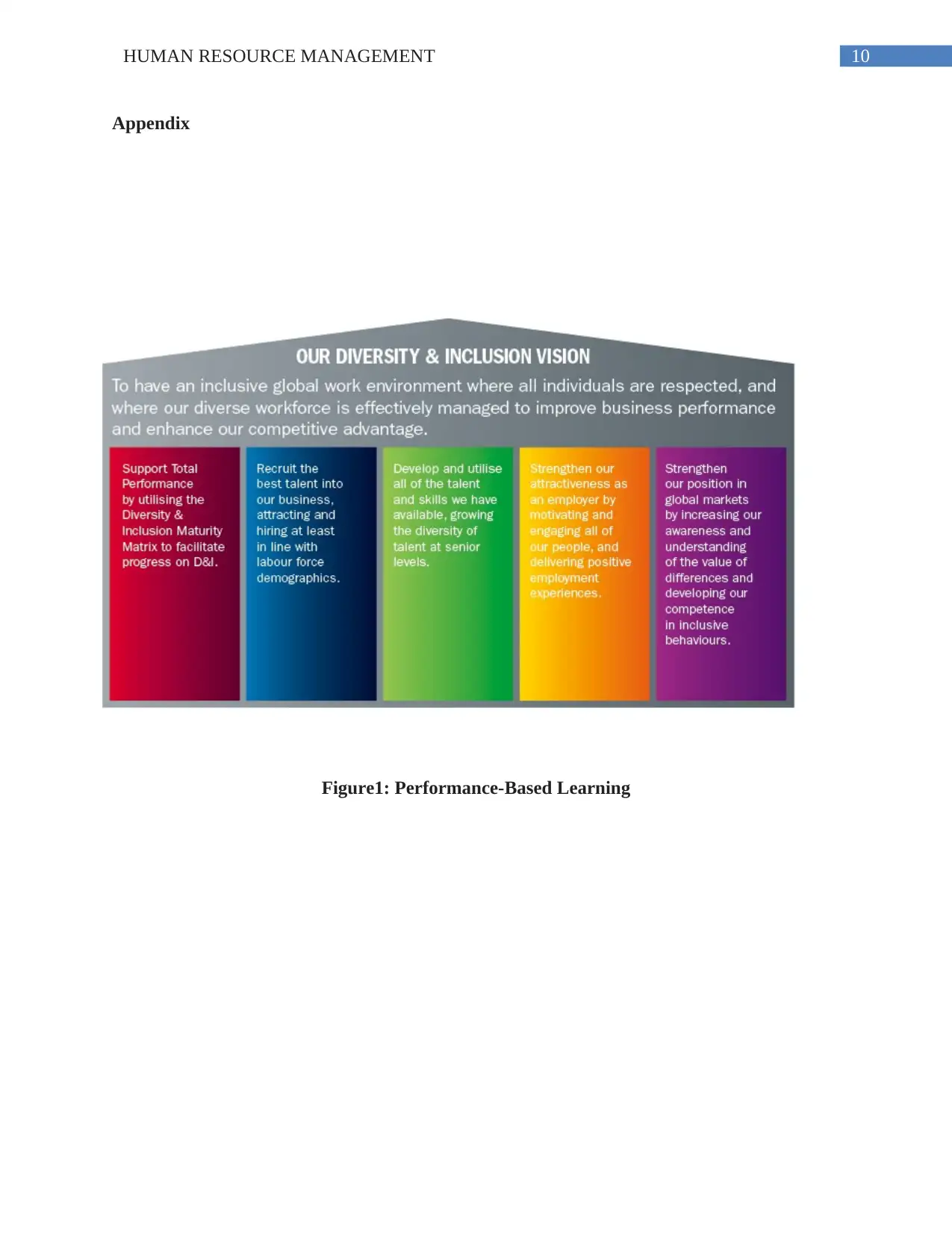
10HUMAN RESOURCE MANAGEMENT
Appendix
Figure1: Performance-Based Learning
Appendix
Figure1: Performance-Based Learning
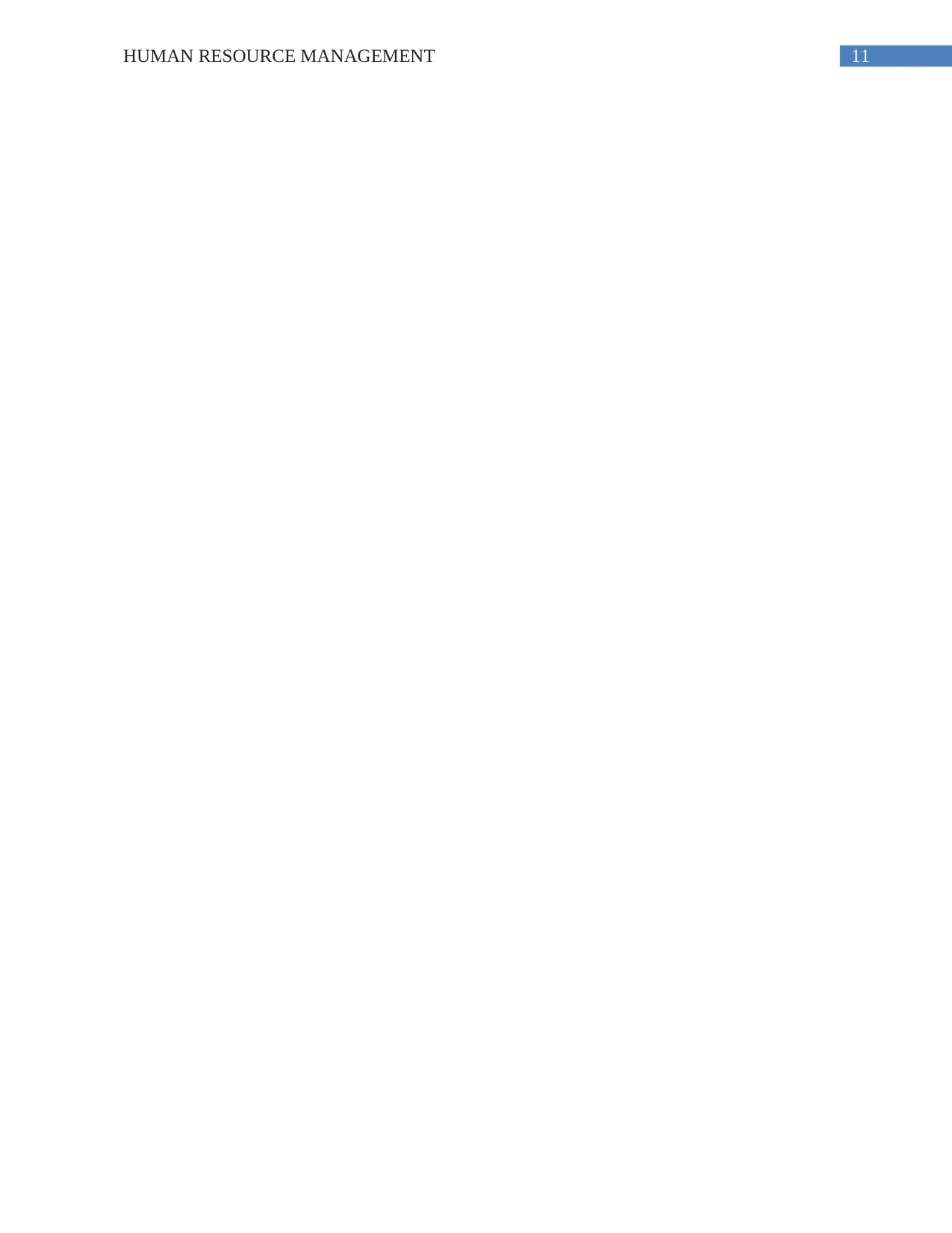
11HUMAN RESOURCE MANAGEMENT
⊘ This is a preview!⊘
Do you want full access?
Subscribe today to unlock all pages.

Trusted by 1+ million students worldwide
1 out of 12
Related Documents
Your All-in-One AI-Powered Toolkit for Academic Success.
+13062052269
info@desklib.com
Available 24*7 on WhatsApp / Email
![[object Object]](/_next/static/media/star-bottom.7253800d.svg)
Unlock your academic potential
Copyright © 2020–2025 A2Z Services. All Rights Reserved. Developed and managed by ZUCOL.





